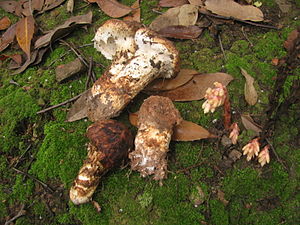Short Summary
Matsutake mushrooms are delicious, expensive and wild, since the artificial cultivation of matsutake has not yet been successful. The "Whole Bidding Systems" for matsutake are one expression of iriaiken, a form of traditional Japanese commons. Iriaiken were mostly established during the dramatic socio-economical changes after the Meiji Period, and have persisted successfully for centuries.Location: Oka Village, Japan

An example of matsutake. source ![]()
Profile
Since the mid-19th century, the commercialization of matsutakes has rapidly expanded (some are sold for more than 1000 USD a kilo). The annual yield of matsutake peaked in the 1950s and has declined drastically since the 1960s due to two factors:
- The decline of their habitats—especially the disappearance and disease of the Japanese red pine with which matsutake is associated
- Disconnection from "traditional commons practices,” such as collective harvesting, clearing undergrowth and leaf litter gathered as fuel or fertilizer, thereby thinning the forests and improving the growth conditions for the mushrooms
Despite the high market price of matsutake, it was harvesting pressure was not the source of the decline. Rather, these problems could not be resolved, where a modern individual property rights framework was applied. But they could be resolved where a spirit of the commons prevailed:
"[H]abitat for matsutake was not improved when land owners were guaranteed the gathering rights to matsutake growing on their own individual lands. Instead, habitat improvement was most successful and matsutake production was highest on community-owned lands in Oka." (Saito/Mitsumata, p.1)
The study to which we refer focuses on the Kyoto region. In 1978, the Association for Promotion of Matsutake Production of Kyoto was established. Deliberate operations to promote habitat improvement throughout the prefecture began. The work of the association, which did not consist of individual villagers but of villages, was subsidized with 50% funding of the Japanese government and 10% by the prefecture. In 1985, habitat improvement operations were conducted "on 405 sites totaling 310 ha in 15 districts (Fujita 1987), and in almost all cases the sites were communal forests as opposed to privately held lands" (p.8).

A Korean dish called Songi gui (송이구이) containing grilled matsutake. source ![]()
When communal forests were divided and privatized after the Meiji Period, many villages adopted a so-called Whole Bidding System:
"Under the Whole Bidding System, even if a villager owns a matsutake-yama (a forest or mountain where matsutake grows), he must bid for the right to harvest the matsutake growing on that land. ... and those who do hold the exclusive rights to the gathering and selling of matsutake and related benefits (eating, gifting) change from year to year through the bidding process." (Saito & Mitsumata, p.3)The illustration below explains the conception of individual, formal property and actual use rights. What is under the surface, what nurtures the matsutake and generates abundance, belongs to all villagers regardless of formal property rights above the surface. Therefore, all villagers are entitled to make decisions regarding the actual use rights of what grows on the commonly and individually owned plots.

Saito & Mitsumata: p. 17., fig.6
source ![]()
Governance
Kyoto Prefecture is famous for matsutake production and consumption. A unique traditional bidding system for matsutake gathering was developed over the centuries, dating back to "1665, when Kamigamo shrine called for bids to sell the gathering rights ... in its forests to inhabitants in the neighborhood, and then collected the bidding income as well as a tax on the amount gathered "(p. 2). The first village bidding processes in Kyoto prefecture date back to the 19th century. By the mid-20th century almost all villages in Kyoto Prefecture had village matsutake bids.How the Whole Bidding System works in Oka
The terrain is divided into five parcels, and gathering rights for three of the five parcels are auctioned off, as in other villages. However, two parcels are reserved for weekly gathering expeditions by cooperative members; these are held every Sunday during the matsutake season at one of the two designated parcels."All participants climb up to the forest at the same time and gather matsutake together . . . Afterwards the harvested matsutake are assembled and distributed to all participants in equal amounts, except when they are reserved for a joint feast that is held after the harvesting . . . This practice is notable because it is highly unusual for villagers to maintain matsutake rights collectively during both the gathering and disposal or consumption phases. No complaints have been made about these customs in Oka" (Saito & Mitsumata, p.14).The two types of parcels rotate—a parcel that is bid out one year may be reserved for joint harvest the next year. Only the Cooperative’s members are allowed to participate in the bidding meeting and joint harvesting. All income from bids goes to the Cooperative, to be spent on services for members and tools for habitat improvement.

Saito & Mitsumata, p.4, fig. 1
source ![]()
Finances
Almost all of the Cooperative’s revenue comes from matsutake bidding income with no remarkable decline in recent years (as of a study dating from 2004). The Oka cooperative gained ¥329,000 in 2003 from bidding income, which is not distributed to each member in cash, but used for a group tour each year (paying part of the cost). Matsutake production is stable thanks to continuous habitat improvement efforts, where deyaku (a system of compulsory work days) is practiced. Members can choose a preferred day from two days designated for deyaku. Members who don’t participate in deyaku must pay a ¥7,000 penalty to the cooperative, but the majority take part, so there is minimal income from such sanctions.Sources
- H. Saito and G. Mitsumata (2008): Reviving Lucrative Matsutake Mushroom Harvesting and Restoring the Commons in Contemporary Japan, Ostrom Workshop
- Anna Lowenhaupt Tsing (2015): The Mushroom at the End of the World: On the Possibility of Life in Capitalist Ruins, Princeton University Press, Princeton and Oxford, pp. 268-274.
- Wikipedia article about matsutake